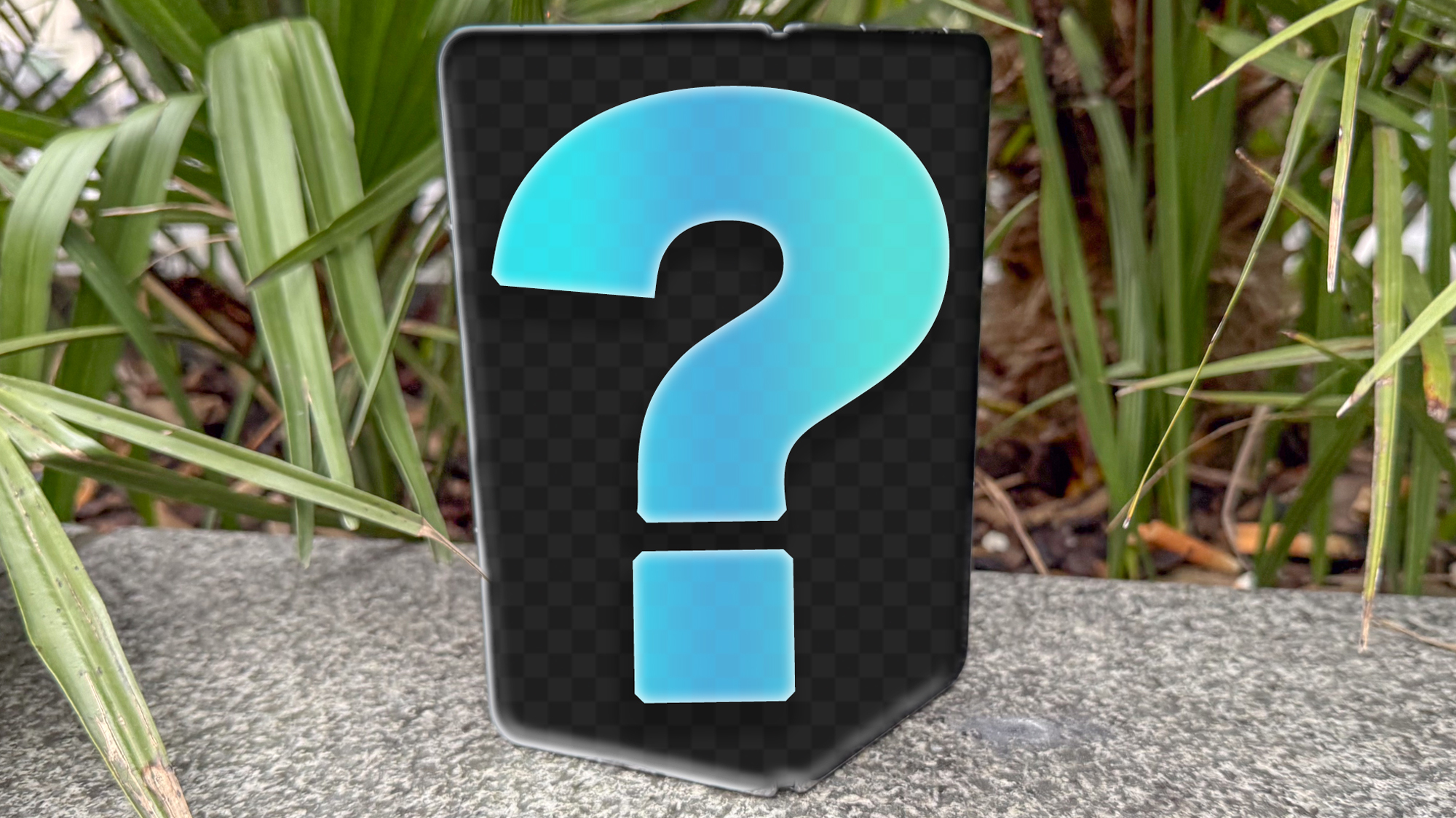iPhone 14 vs. Samsung Galaxy S22: Which phone wins?
Here's how the Apple's current flagship compares to Samsung's older phone
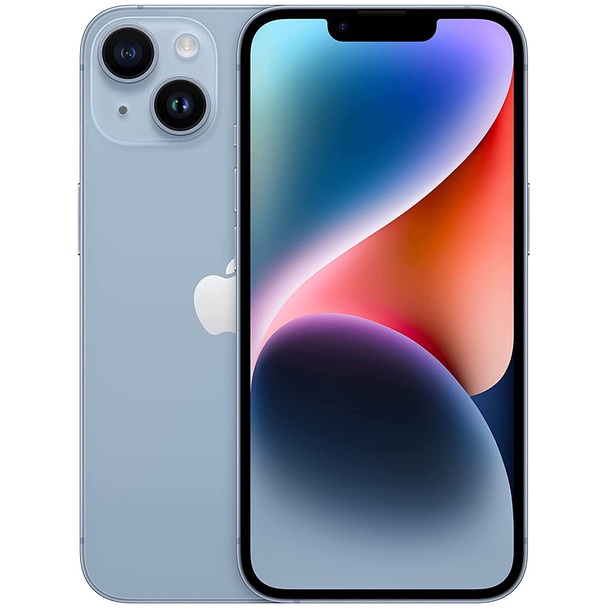
Even without a dedicated telephoto lens or an adaptive refresh rate, the iPhone 14 edges ahead of the Galaxy S22. It's got a better chipset than Samsung's phone, and its photo-processing software produces better images. It also lasts longer on a charge and you can expect lengthier software support.
Pros
- Excellent cameras
- Vibrant display
- Fast A15 Bionic performance
Cons
- Still just 60Hz refresh rate
- No optical zoom

Now that it starts at $699, the Galaxy S22 delivers even more value, even for a phone that debuted in 2022. It's the phone to get if you want a telephoto lens and an adaptive refresh rate. And Samsung will support this phone with three more software updates.
Pros
- New low price
- Bright, colorful display
- Telephoto lens
Cons
- Below-average battery life
- Not as fast as A15-powered phones
A iPhone 14 vs. Samsung Galaxy S22 face-off remains relevant, even if the S22 is no longer the new kid on the block. These days, Samsung is all about its new Galaxy S23 phones, which run on a faster processor than the one used by the 22. Still, Samsung has kept the Galaxy S22 around at a lower price, so you'll want to consider how it measures up to the iPhone 14 if you to save on your next smartphone purchase.
You may find flashier phones from Apple and Samsung, whether it's the iPhone 14 Pro Max or the Galaxy S23 Ultra. (Read our Galaxy S23 Ultra review to see why we think this is now the best phone you can buy.) But with their more affordable price tags, the iPhone 14 and Galaxy S22 are the ones more people are going to turn to. So which one is better?
The iPhone 14 certainly can make a compelling case as the phone to get when you've got $799 to spend. Even though Apple has stuck with a variation on last year's A15 Bionic chipset for the iPhone 14, the new handset outmuscles the Galaxy S22. The camera setup has seen some changes as well to improve low-light photography, and Apple has added some new safety features like crash detection and the now-live Emergency SOS with satellite.
But don't dismiss the Galaxy S22, even if it's not Samsung's latest and greatest flagship. Its processor may not be as fast as what Apple packs inside the iPhone, but the Galaxy S22 delivers solid performance for its reduced price — and unlike the standard iPhone 14, you'll find a telephoto lens on the back of Samsung's phone and a 120Hz display.
This iPhone 14 vs. Samsung Galaxy S22 face-off looks at how the phones compare, along with our head-to-head testing of the phones' displays, cameras, batteries and more. (And for a more recent comparison, check out our Samsung Galaxy S23 vs. iPhone 14 head-to-head showdown.)
iPhone 14 vs. Samsung Galaxy S22: Specs
| Row 0 - Cell 0 | iPhone 14 | Samsung Galaxy S22 |
| Starting price | $799 | $699 |
| Screen size | 6.1-inch OLED (2532 x 1170) | 6.1-inch AMOLED (2340 x 1080) |
| Refresh rate | 60Hz | 48Hz - 120Hz |
| CPU | A15 Bionic | Snapdragon 8 Gen 1 |
| RAM | 6GB | 8GB |
| Storage | 128GB, 256GB, 512GB | 128GB, 256GB |
| Rear cameras | 12MP wide (f/1.5), 12MP ultrawide (f/2.4) | 50MP wide (f/1.8); 12MP ultrawide (f/2.2); 10MP telephoto (f/2.4) with 3x optical zoom |
| Front camera | 12MP (f/1.9) | 10MP (f/2.2) |
| Battery size | 3,279 mAh | 3,700 mAh |
| Battery life | 9:28 | 7:51 |
| Charging speed, wired | 20W | 25W |
| Size | 5.8 x 2.8 x 0.3 inches | 5.7 x 2.8 x 0.3 inches |
| Weight | 6.1 ounces | 5.9 ounces |
| Color options | Midnight, Starlight, Blue, Purple, Product [RED] | Phantom Black, Phantom White, Green, Pink Gold, Bora Purple |
iPhone 14 vs. Samsung Galaxy S22: Price and availability
At the start of this year, there was nothing separating the iPhone 14 and Galaxy S22 in terms of cost. Both phones were available for $799 for a 128GB base model.
The arrival of the Galaxy S23 meant a price drop for the S22, though, with Samsung selling the older phone for $699. Upgrading to a 256GB model costs an additional $60 meaning you can get a Galaxy S23 with double the storage for the base model iPhone 14 for $40 less.
Get instant access to breaking news, the hottest reviews, great deals and helpful tips.
iPhone storage upgrades cost an extra $100 to get you to 256GB. There is a 512GB iPhone 14, something Samsung doesn't offer with the Galaxy S22.
Both phones are available from a variety of carriers and retailers. The best iPhone 14 deals and Galaxy S22 deals can help you save money on either device. Be aware that if you buy an unlocked iPhone 14 directly from Apple, you can expect to pay another $30 on top of the base rate — that's an extra fee Samsung doesn't charge for its phone.
Because of the lower starting price and the cheaper storage upgrade, the edge goes to the Galaxy S22 here.
Winner: Samsung Galaxy S22
iPhone 14 vs. Samsung Galaxy S22: Design
Neither the iPhone 14 or Galaxy S22 reinvent the wheel when it comes to phone design. In fact, you could even call them dead ringers for their predecessors.
That's a little disappointing in the iPhone 14's case, since Apple did mix things up on the iPhone 14 Pro models by ditching the notch on those phones' displays and going with a Dynamic Island feature instead. (Dynamic Island not only houses the front camera and Face ID sensors, but it's also where Live Activities and other alerts appear.) The notch remains on the iPhone 14, taking up as much space as it did on the iPhone 13.
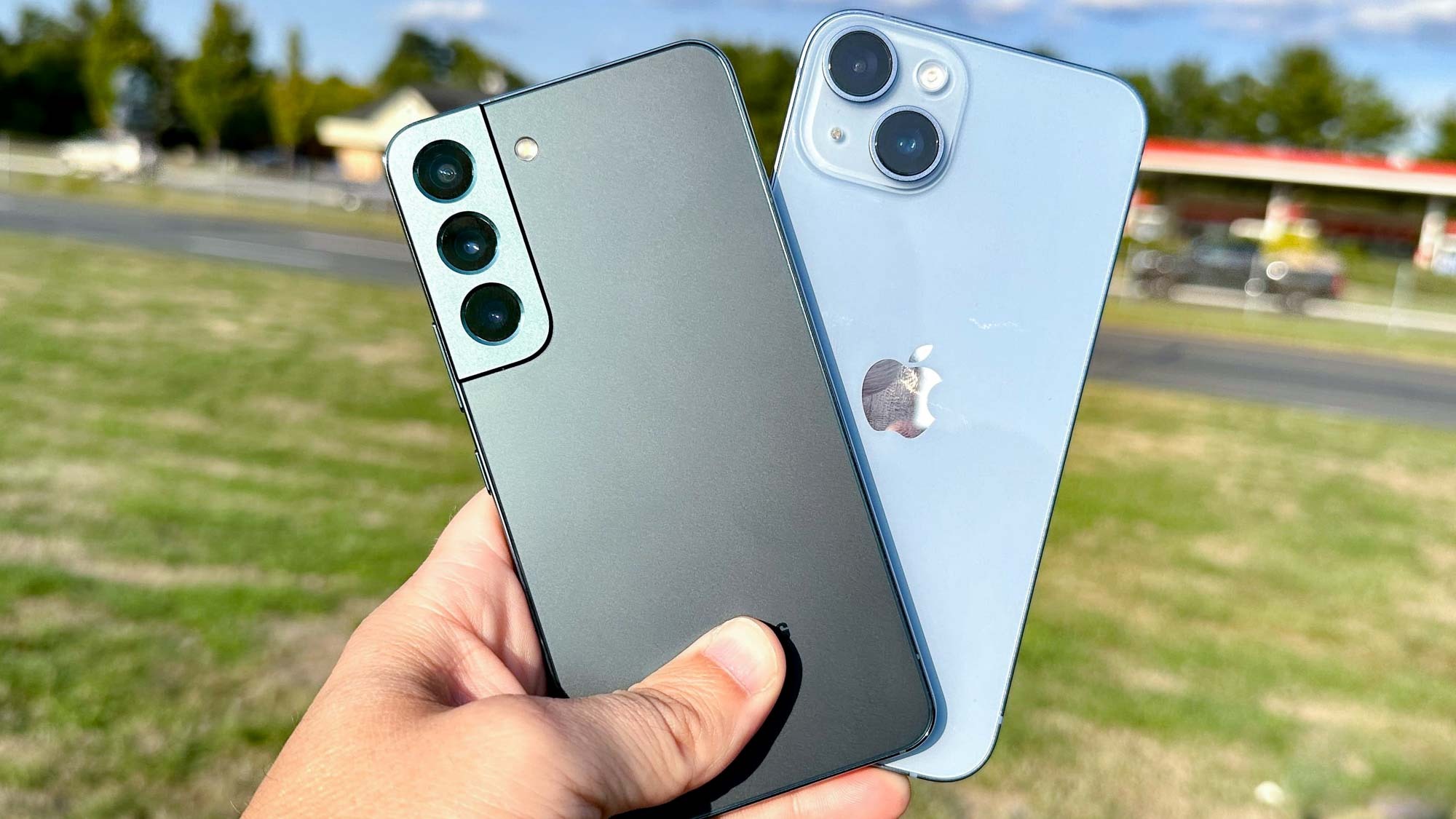
The iPhone 14 and Galaxy S22 have similar sizes — the iPhone's slightly taller — and Samsung's phone is about 0.15 ounces lighter. Both phones use a mixture of glass and metal for their materials.
Some features do help the two phones stand out from one another. The S22 has an in-display fingerprint reader while Apple skips out on that, relying entirely on Face ID unlock your phone and handle mobile payments.
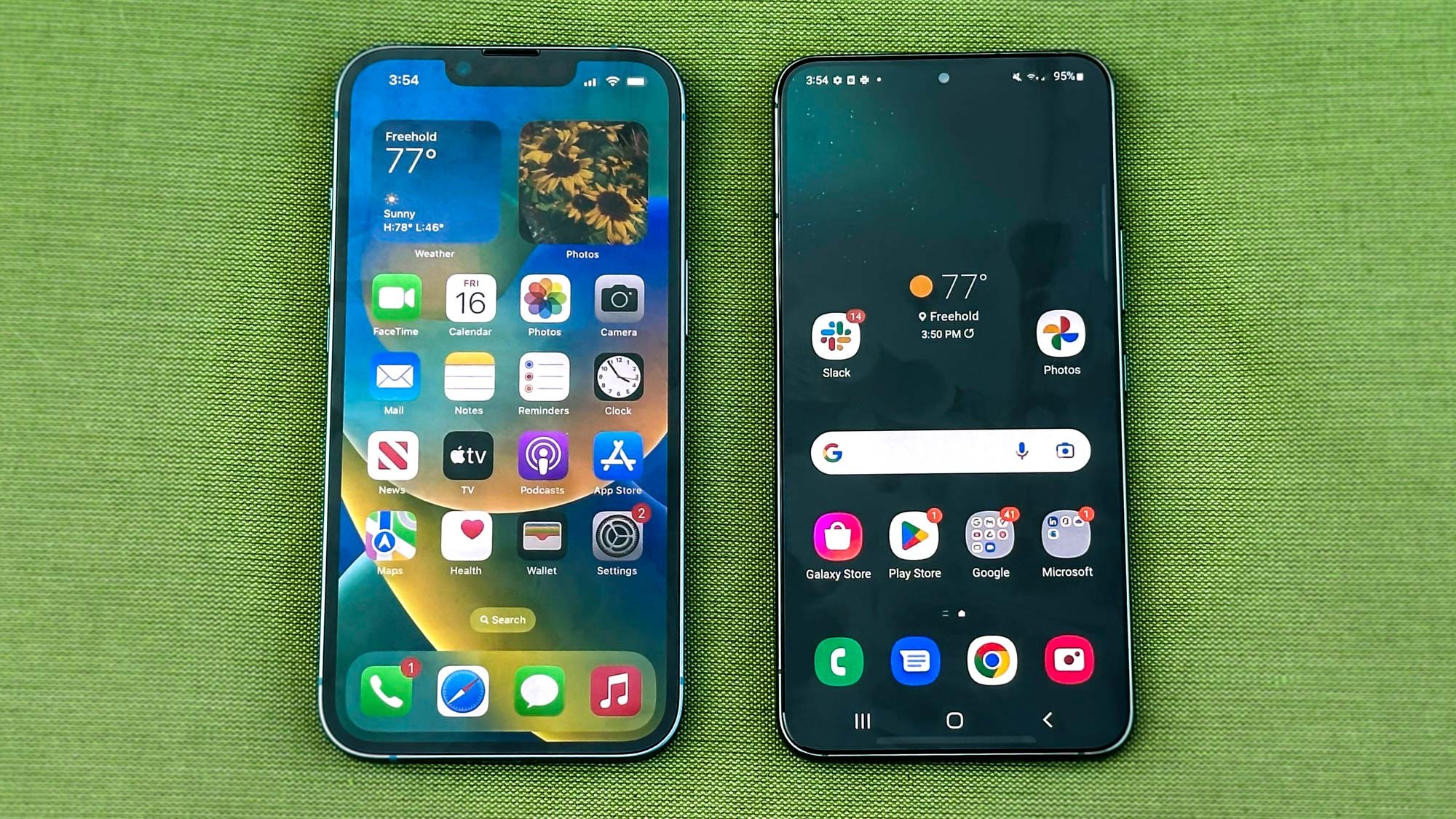
The most noteworthy iPhone 14 vs. Samsung Galaxy S22 design difference involves the SIM card tray — the S22 has one, and the iPhone does not, at least not for models in the US. The iPhone 14 relies solely on eSIM technology, and while that's certainly convenient for switching phone service, international travelers may prefer to swap out physical SIM cards, particularly in countries where carriers have yet to embrace the eSIM movement.
Winner: Samsung Galaxy S22
iPhone 14 vs. Samsung Galaxy S22: Display
The iPhone 14 and the Galaxy S22 feature similarly sized displays — both are 6.1-inch OLED panels, with the iPhone 14's resolution (2532 x 1170) a bit sharper than the S22's (2340 x 1080).
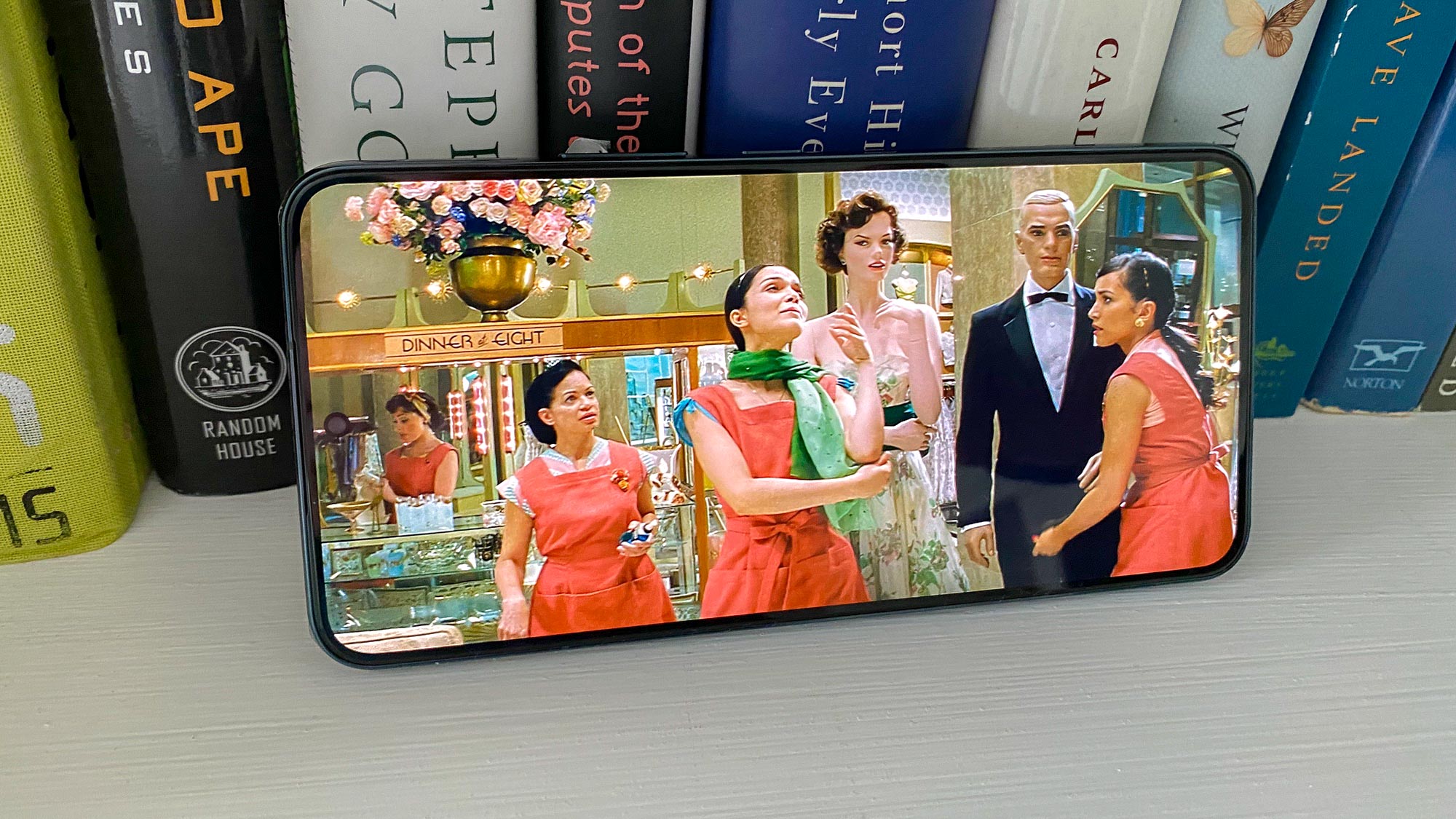
Yet, the Galaxy S22 can automatically adjust its refresh rate, scaling up to 120Hz when you'll see the benefit of smoother scrolling or more immersive graphics and ramping down to 48Hz when the screen is more static to preserve battery. The iPhone 14 doesn't adjust its 60Hz refresh rate at all, as that's a feature Apple reserves for its Pro models.

The Galaxy S22's display outshines the iPhone 14's in another key way — literally. While the iPhone 14 is plenty bright, promising a peak brightness of 1,200 nits in HDR, the Galaxy S22's brightness peaks at 1,300 nits. (The Galaxy S23 goes even brighter, with a 1,760-nit panel.)
We also found colors more vibrant on the Galaxy S22 when setting that phone's display to Vivid mode. Those colors were more accurate, too, given the Galaxy S22's Delta-E score of 0.22 to 0.25 for the iPhone 14. (Number closer to zero are better.)
| Row 0 - Cell 0 | iPhone 14 | Samsung Galaxy S22 |
| Refresh rate | 60Hz | 48-120Hz |
| Mac brightness (nits) | 757 nits | 1,152 nits |
| sRGB color gamut (%) | 117.4% | 210.4% (vivd), 110% (natural) |
| DCI-P3 color gamut (%) | 83.1% | 149.1% (vivid) 77.9% (natural) |
| Delta-E rating | 0.25 | 0.33 (vivid), 0.22 (natural) |
You'll certainly enjoy looking at the iPhone 14's screen when it's time to watch videos, look at photos or play games. But the Galaxy S22 offers a better screen, as its dynamically adjusting display rate pushes it ahead of the iPhone 14. You can read more about how the displays on these phones compare to one another, and where the Pixel 7 fits into the mix — in our three-way display face-off.
Winner: Samsung Galaxy S22
iPhone 14 vs. Samsung Galaxy S22: Cameras
The iPhone 14 sees some key camera improvements, particularly when it comes to low-light photos. While the new phone still uses a 12MP sensor for its main camera — only the iPhone 14 Pro models got a beefed-up 48MP shooter — the sensor itself is physically larger with 1.9 micrometer pixels and a faster f/1.7 aperture.
In theory, that translates to better photos in low light and better action shots than before — and having tested the iPhone 14, we can certainly see the impact of that larger sensor. As for the 12MP ultrawide camera on the iPhone 14, it captures more of the scene and promises better low-light performance, too.
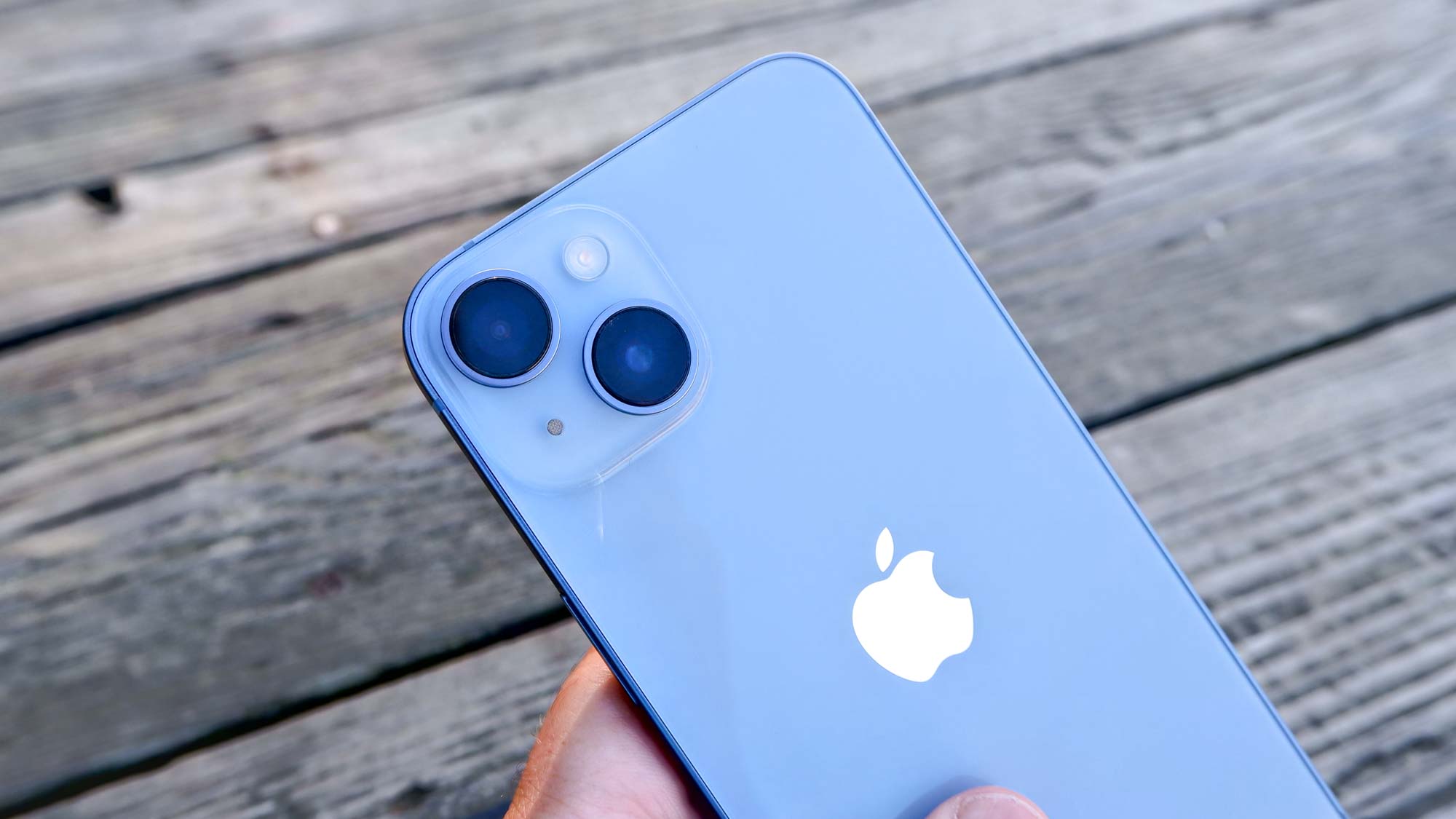
Still, the Galaxy S22 offers something the iPhone 14 doesn't — at least not unless you spring for a more expensive Pro version. There's a 10MP telephoto lens on the back of the Galaxy S22, joining the phone's 50MP main camera and 12MP ultrawide shooter.
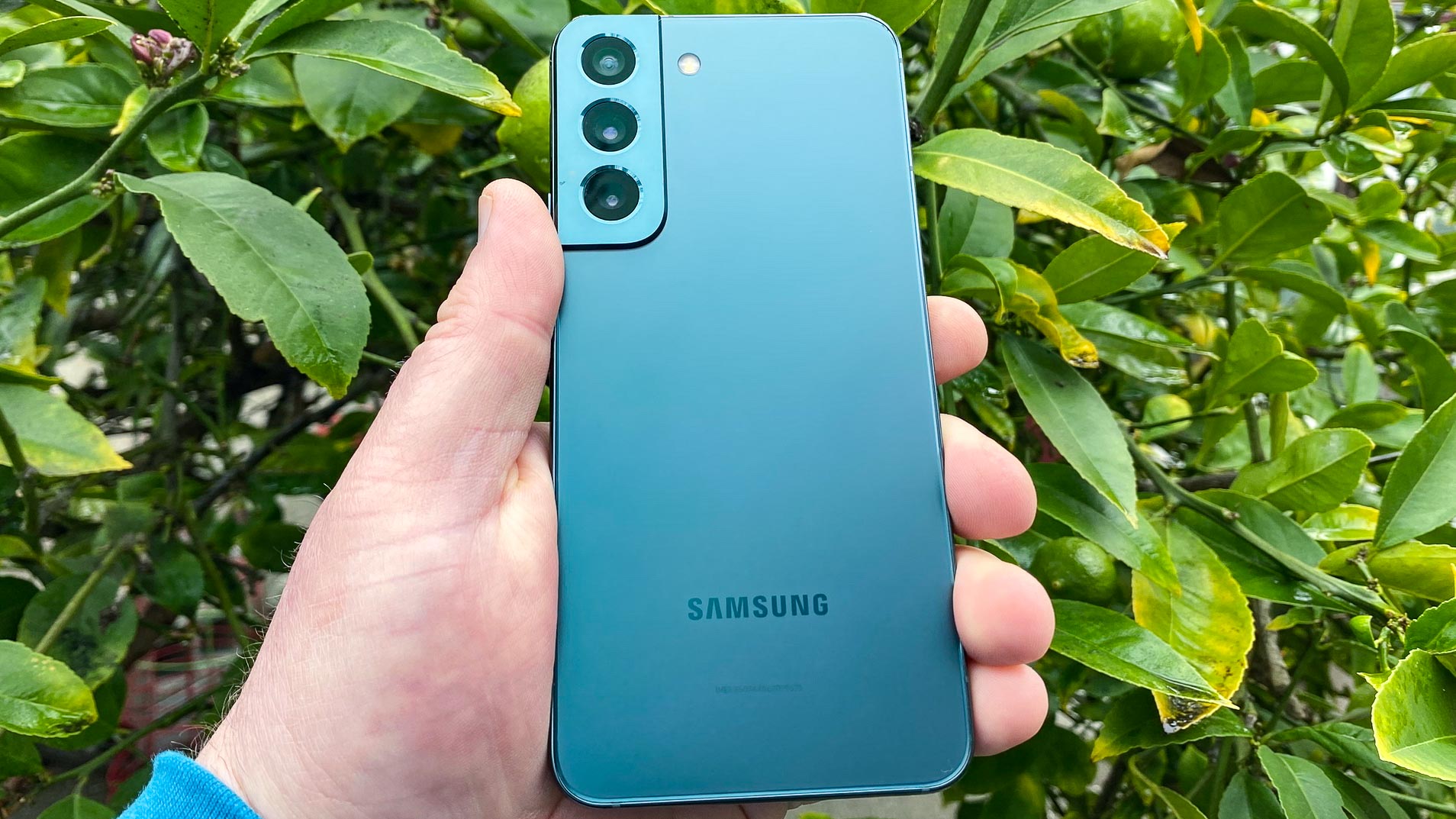
As a result, the S22 can pull off a 3x optical zoom, while the iPhone 14 is limited to a 5x digital zoom. (The Galaxy S22's digital zoom goes up to 30x, but who's counting?)
You can see the benefit of a dedicated zoom lens when my colleague Mark Spoonauer took these shots of the Chrysler Building using the iPhone 14's 5x maximum zoom. The iPhone 14's colors are very true-to-life, and it captures a lot more detail. But that's at the expense of the sky in the background, which is a much deeper shade of blue in the S22 shot. If we were to keep zooming in with the S22's telephoto lens, we'd capture even more detail than the iPhone 14 is capable of.
For the most part, though, the iPhone 14 reaps the rewards of the hardware changes Apple made to the phone's cameras and the new Photonic Engine that calls out more detail during image processing. The leaves and petals of these dipladenia flowers are more detailed in the iPhone's rendition. You can make out water droplets that blend into the background of the S22 shot.
The iPhone 14's photo-processing prowess is very much on display in this portrait shot of Mark Spoonauer. Both phones do a good job of separating Mark from the background, though if you ask me, the Galaxy S22 goes a little overboard with highlighting the subject to the point where it looks like we've Photoshopped Mark into his own backyard. The S22's blur is a little over-aggressive, too, whereas the iPhone 14 shot feels more natural and stylish.
Apple gave the TrueDepth camera on the front of every iPhone 14 model a boost, adding autofocus and widening the aperture to let in more light. Perhaps, that explains how the iPhone 14 handled sun and shadows in this selfie of Mark. The iPhone 14 does a little better keeping Mark's face lit while the Galaxy S22 seeks to obliterate shadows altogether, over-smoothing Mark's face in favor of more consistent tones. (Look how consistent the grass in background of the S22's image is — it's patchier in the iPhone 14 photo, but probably more realistic.)
I'm hard-pressed to pick a winner in this shot testing the night features on both camera phones. The shot of Star Wars figurines was captured in a very dark room so the fact that the iPhone 14 and Galaxy S22 produced any recognizable image is commendable.
I think the S22 does a slightly better job of making more of Darth Vader's mask emerge from the shadows. But I also think this shot highlights the low-light improvements Apple made with the iPhone 14 — there's no way an iPhone 13 produces anything as distinct as what the newer iPhone is able to manage.
On the video front, the iPhone 14's new Action mode is a really strong addition, providing smoother video capture even when you or your subject are on the move. Stacking footage shot by an iPhone 14 on top of Galaxy S22 video with that phone's Super Steady mode, the iPhone video looks smoother and more colorful.
If the iPhone 14 only had a telephoto lens, this photo face-off would be a walkover for Apple's camera phone. Instead, the contest winds up being a little closer, though this is still a clear Apple win.
Winner: iPhone 14
iPhone 14 vs. Samsung Galaxy S22: Performance
Apple's dominance in raw performance numbers doesn't change, even though the new iPhone 14 uses an older processor, last year's A15 Bionic. While that chip powered all four iPhone 13 models, Apple's actually turned to the one found in the Pro models to power this year's flagship.
That means the A15 Bionic in the iPhone 14 has a 5-core GPU instead of a 4-core one as found in the iPhone 13's version of the chipset. The result is a modest bump in benchmark results for Apple's new phone over the older model. For our purposes, though, it also means a wider gap between the iPhone 14 and the Snapdragon 8 Gen 1-powered Galaxy S22.
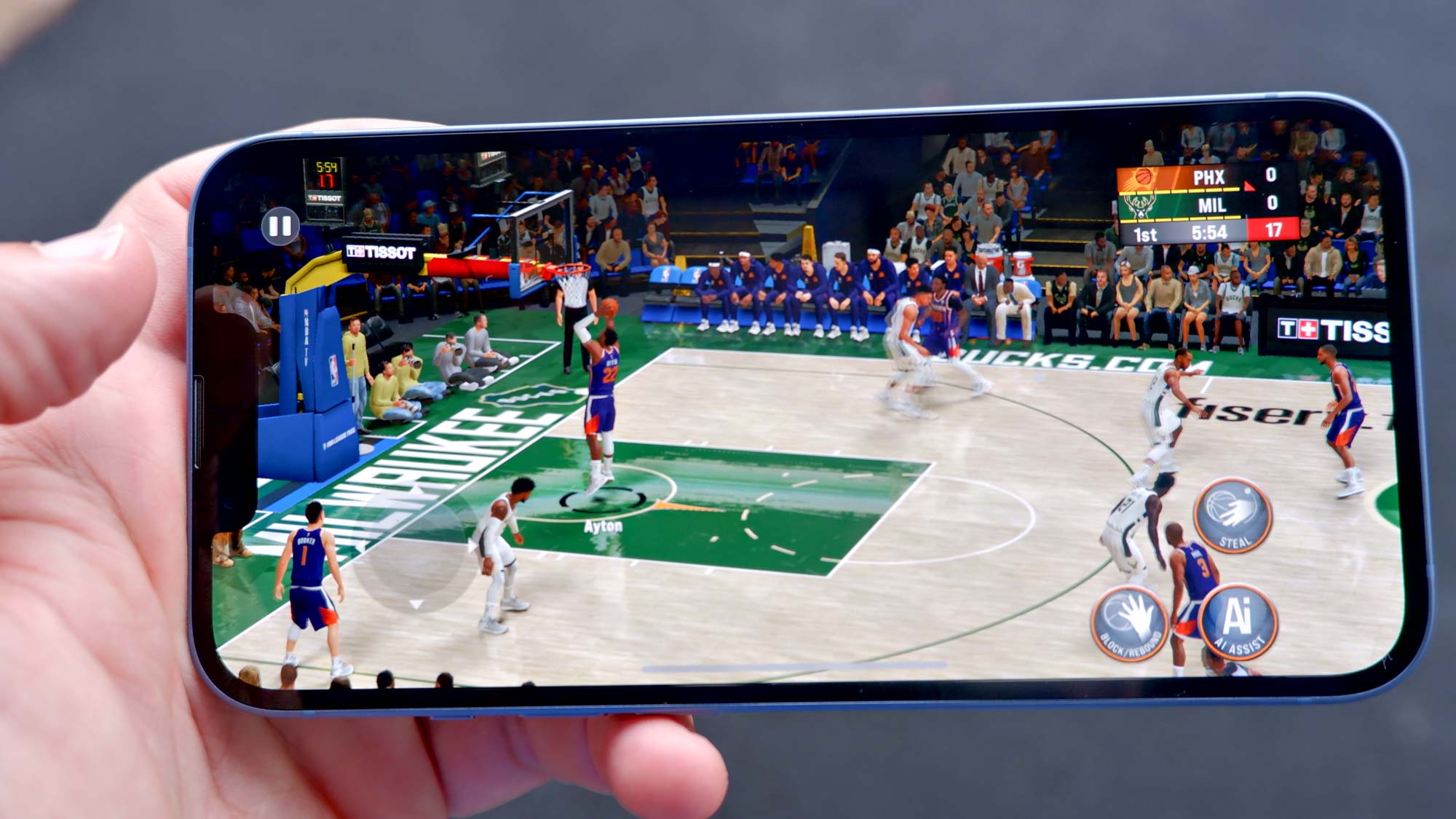
In Geekbench, which measures general performance, the iPhone 4 posted single- and multicore scores of 1,727 and 4,553, respectively, topping the S22's 1,222 and 3,341 results. The iPhone 14 also posted a better score in the gaming benchmark we run, churning out 69 frames per second in 3DMark's Wild Life Unlimited test while the S22 produced just less than 60.
| Row 0 - Cell 0 | iPhone 14 | Galaxy S22 |
| Geekbench single-core result | 1,727 | 1,222 |
| Geekbench multicore result | 4,553 | 3,341 |
| Wild Life Unlimited (FPS | 69.1 | 59.7 |
| Video transcoding test (Mins:Secs) | 0:28 | 0:48 |
An upgraded A15 chipset also helped the iPhone 14 finish ahead of the Galaxy S22 in our real-world test in which Adobe Premier Rush transcodes a 4K video. The iPhone 14 finished that task in 28 seconds to the Galaxy S22's 48-second time. That's a noticeable gap.
If you want a Samsung phone that keeps better pace with Apple's latest, look for the Galaxy S23 and its Snapdragon 8 Gen 2 chipset. The Galaxy S22 turns in respectable performance, but it's clear that the iPhone 14 is the dominant figure here.
Winner: iPhone 14
iPhone 14 vs. Samsung Galaxy S22: Battery life and charging
We had high hopes for the iPhone 14 battery life, considering how well its predecessor did on our test last year. But the iPhone 14 took a step back in our battery test, in which we have phones surf the web continuously until they run out of power.
The iPhone 14 averaged 9 hours and 28 minutes on our test, which is about half-an-hour behind the average for smartphones. Considering how well the iPhone 14 Plus and especially the iPhone 14 Pro Max do on this same test, we're a little disappointed with that number.
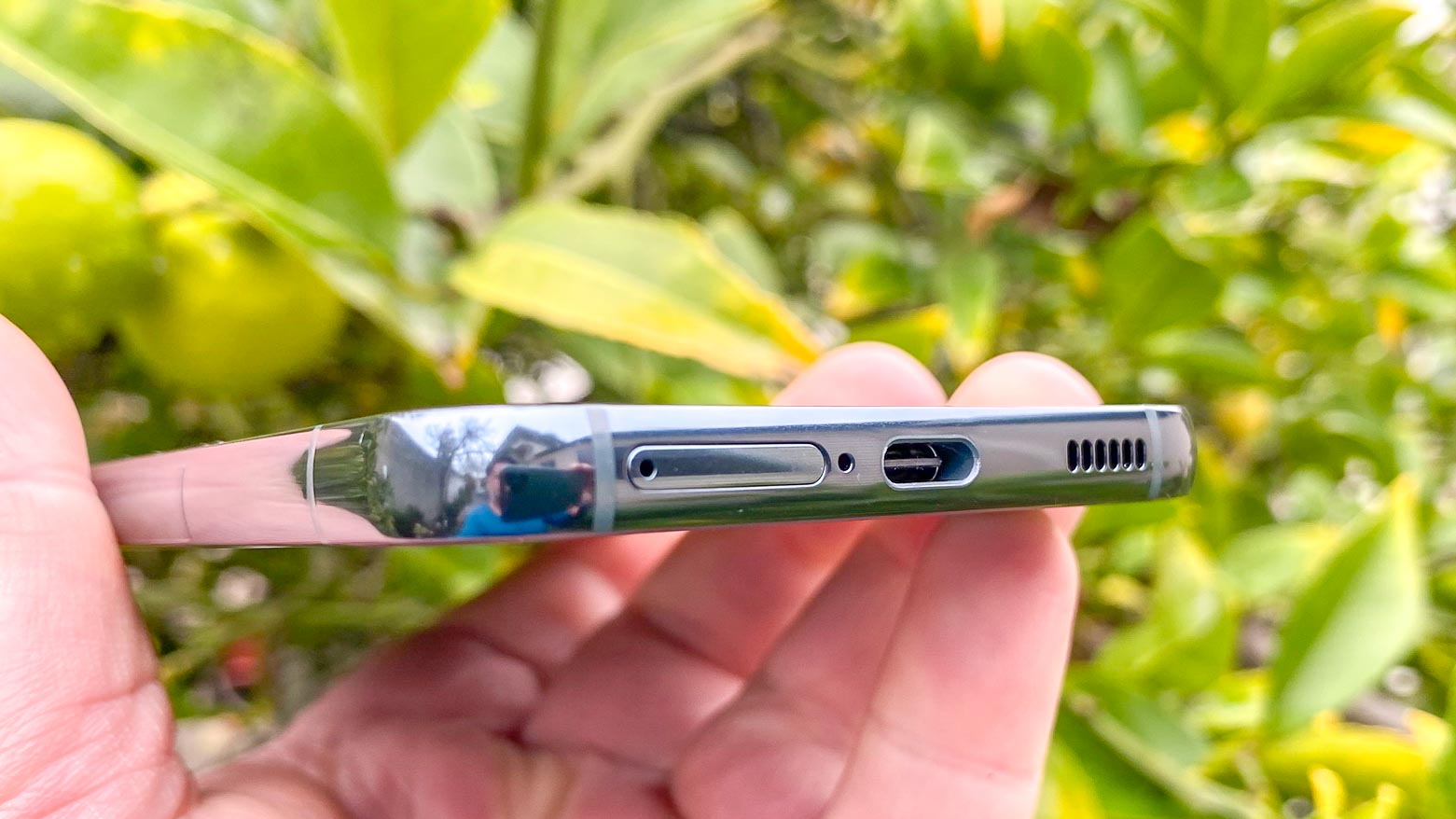
Still, the iPhone 14's result is leagues ahead of the time turned in by the Galaxy S22. That phone lasted for 7 hours and 51 minutes on our battery test, which is around two hours worse than the average phone.
Samsung's flagship beats the iPhone 14 in one area involving battery — it charges faster, supporting 25W charging. While that's not as fast as the other S22 models and their 45W charging speeds, it's still better than the 20W the iPhone 14 charges at.
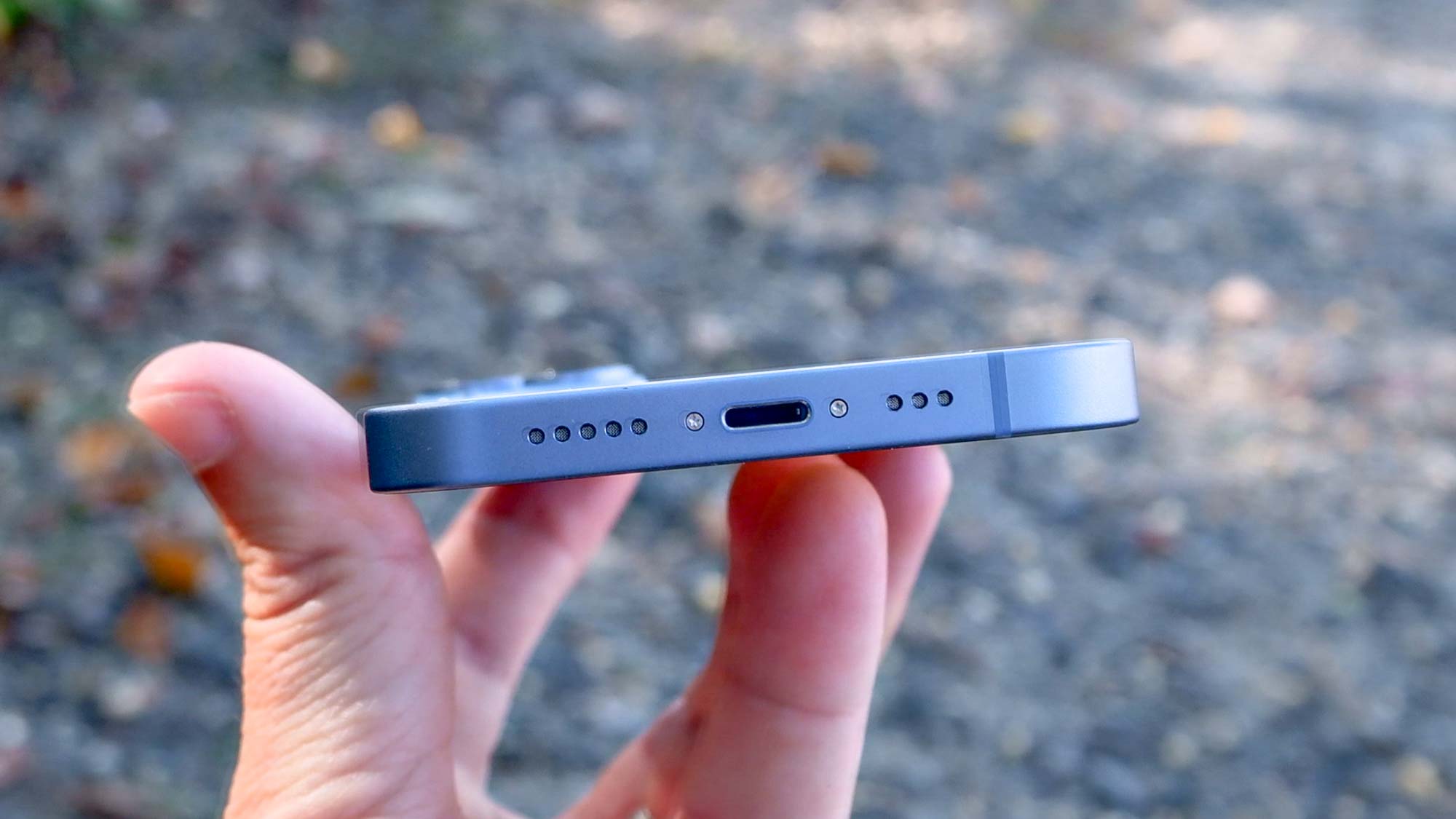
As a result, a drained Galaxy S22 reached a 60% charge after 30 minutes in our testing. The iPhone 14 made it to 54% in that time.
Winner: iPhone 14
iPhone 14 vs. Samsung Galaxy S22: Software and special features
The iPhone 14 ships with iOS 16 preinstalled, meaning all the top features of that software update — the customizable lock screen, the ability to edit text messages, the updated apps — are there for you to use the first time you fire up the phone.
When it comes to Samsung's phones, Android 13 is now available to the S22 via the One UI 5 update. Expect personalization features, new multitasking gestures and deeper Material You integration with the new version of Android.
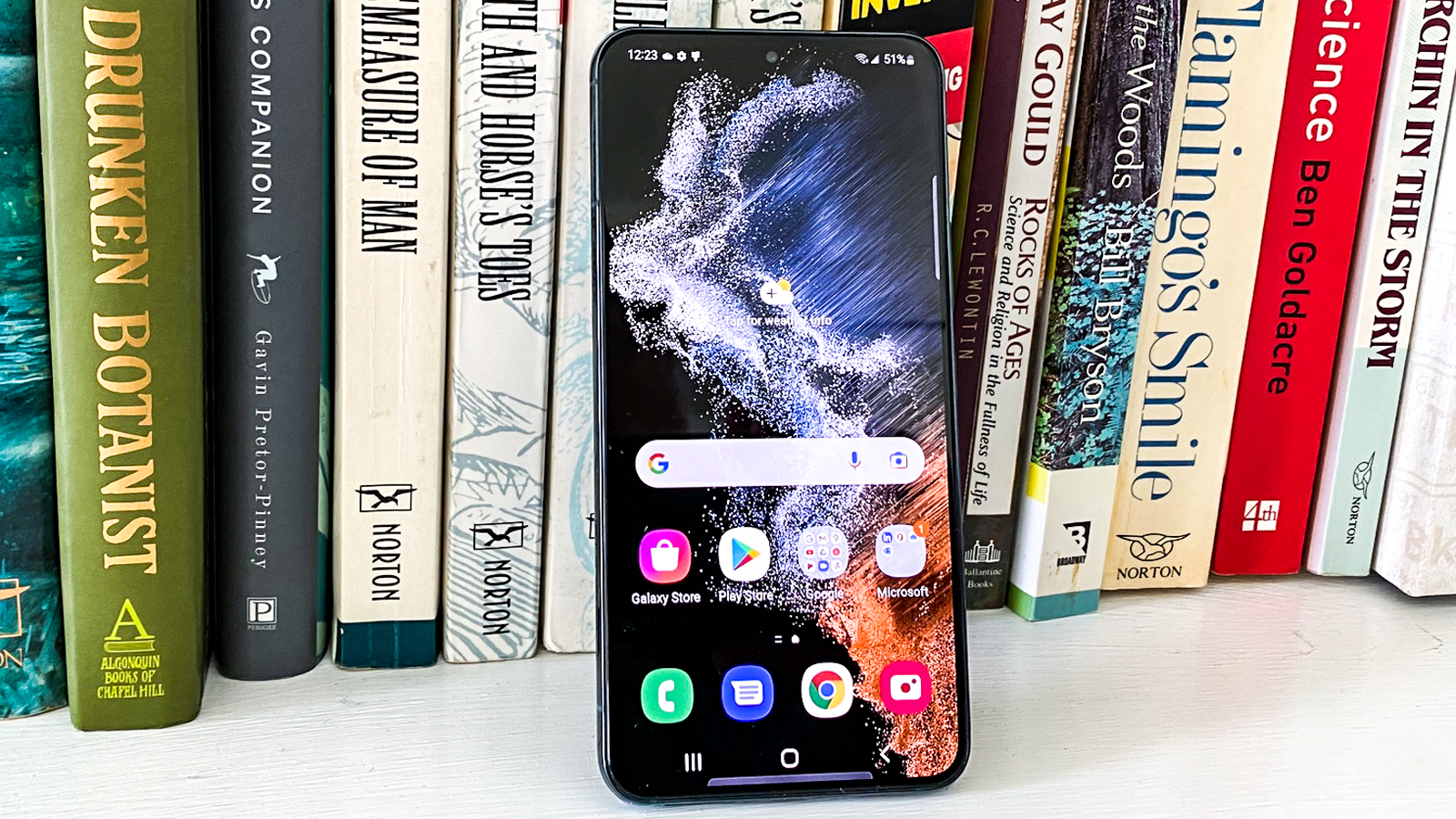
Samsung has gotten better about software support. Android 13 is the first of four guaranteed software updates from Samsung for its Galaxy S22 phones, and there's a fifth year of security updates promised, too. With iPhones, you can usually expect five years of updates, so the support gap is closing.
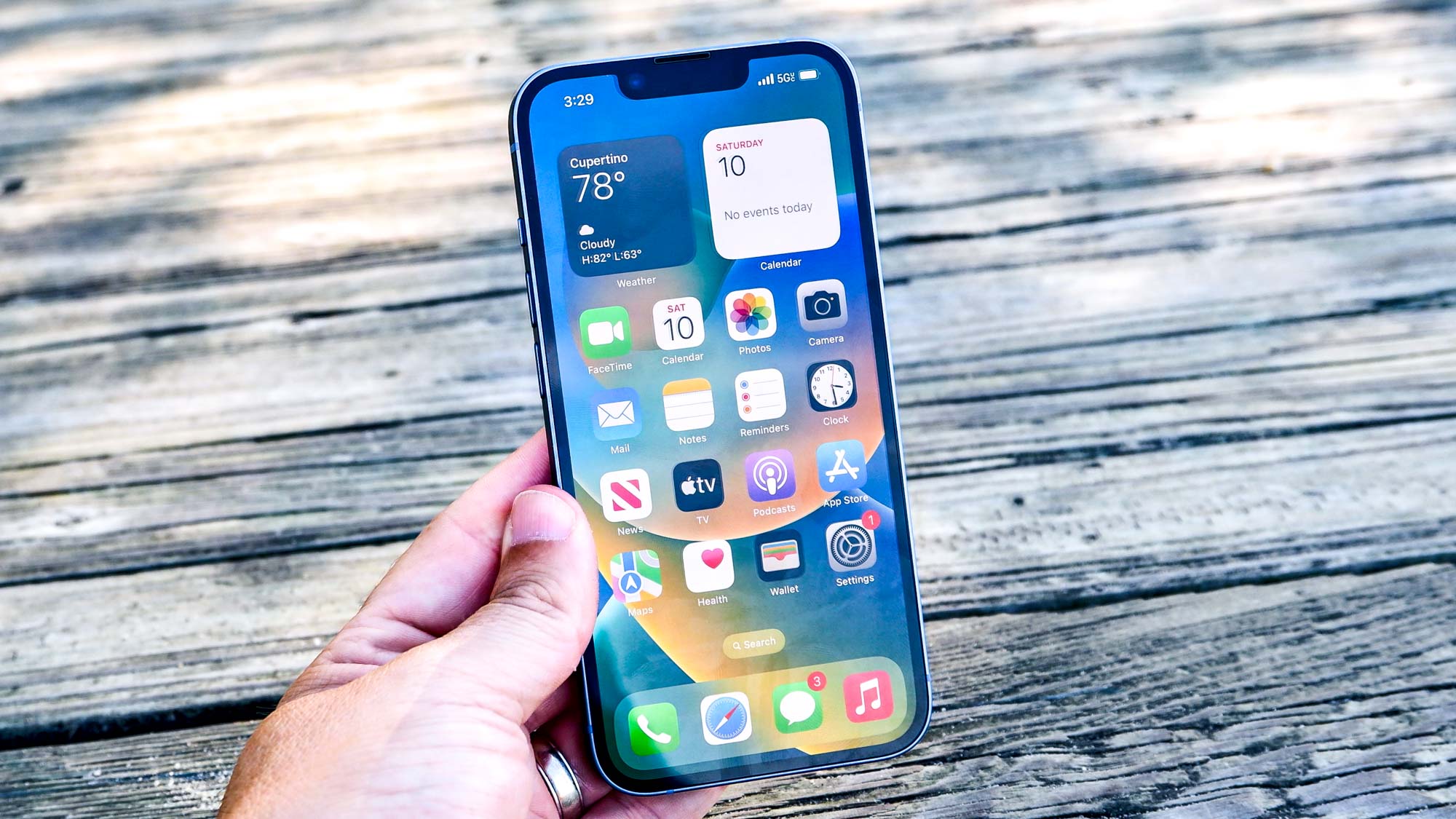
But the iPhone 14 wins this category with two new additions. All four models in the iPhone 14 lineup support crash detection, in which sensors inside the phone can tell if you've been in a car accident; if so, they'll notify emergency responders.
Similarly, an Emergency SOS via satellite feature will tap into satellite connectivity when there's no nearby cellular tower to let you send emergency text messages to responders as well as to your emergency contacts. While the hope is that you never have to use either of these iPhone additions, they certainly make Apple's phone much more valuable to keep close at hand.
Winner: iPhone 14
iPhone 14 vs. Samsung Galaxy S22: Verdict
An iPhone 14 vs. Samsung Galaxy S22 face-off is surprisingly close, especially after the S22's price cut. Samsung's phone may be older, but it delivers more value than before. In contrast, Apple has saved most of its premium features for its Pro lineup.
| Row 0 - Cell 0 | iPhone 14 | Samsung Galaxy S22 |
| Price and availability (10 points) | 7 | 9 |
| Design (10 points) | 8 | 9 |
| Display (15 points) | 12 | 14 |
| Cameras (20 points) | 18 | 17 |
| Performance (20 points) | 20 | 18 |
| Battery life and charging (15 points) | 12 | 11 |
| Software and special features (10 points) | 10 | 8 |
| Overall (100 points) | 87 | 86 |
That said, Apple takes the rest of this camera comparison, and the iPhone continues to outperform the Galaxy S22 even with its older chipset. The software experiences Apple introduces are pretty special, too, with its emergency features helping the iPhone 14 stand out.
Both the iPhone 14 and Galaxy S22 are fine choices for your next smartphone, particularly if you don't want to pay a premium for the more expensive models from either phone maker. But the iPhone 14 rides its cameras, processor and software to a very close victory in this showdown.
Philip Michaels is a Managing Editor at Tom's Guide. He's been covering personal technology since 1999 and was in the building when Steve Jobs showed off the iPhone for the first time. He's been evaluating smartphones since that first iPhone debuted in 2007, and he's been following phone carriers and smartphone plans since 2015. He has strong opinions about Apple, the Oakland Athletics, old movies and proper butchery techniques. Follow him at @PhilipMichaels.

